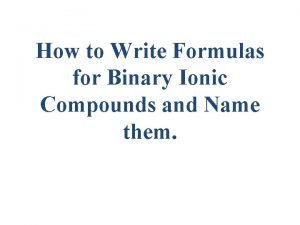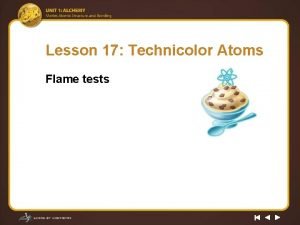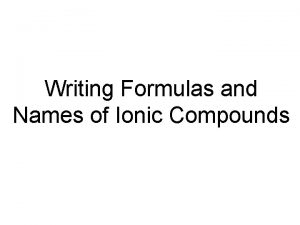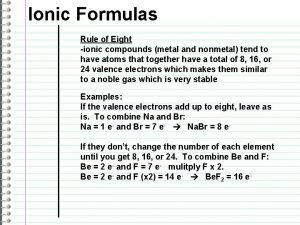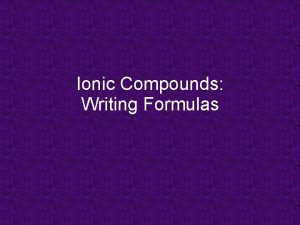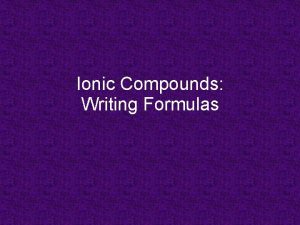Ionic Formulas Rule of Eight ionic compounds metal





- Slides: 5

Ionic Formulas Rule of Eight -ionic compounds (metal and nonmetal) tend to form atoms that together have a total of 8, 16, or 24 valence electrons which makes them similar to a noble gas which is very stable Examples: If the valence electrons add up to eight, leave as is. To combine Na and Br: Na = 1 e- and Br = 7 e- Na. Br = 8 e. If they don’t, change the number of each element until you get 8, 16, or 24. To combine Be and F: Be = 2 e- and F = 7 e- mulitply F x 2. Be = 2 e- and F (x 2) = 14 e- Be. F 2 = 16 e-

Ionic Formulas Nobel gases are an exception. They already have 8 valence electrons, so they are happy the way that they are. =

Ionic Formulas Ions -metals give up electrons -nonmetals take electrons -when metals give up valence electrons, they are left with a slightly positive charge -when nonmetals take valence electrons, they are left with a slightly negative charge For example: metals: Na+1 or Mg+2 nonmetals: O-2 or F-1

Ionic Formulas -when combining metals and nonmetals, total charge should equal zero! -if combining them doesn’t equal zero, change the number of atoms For example: To combine Na and F: Na+1 + F-1 = Na. F and total charge = 0 To combine Na and O: Na+1 + O-2 = -1 NO GOOD! Na+1 (x 2) + O-2 = Na 2 O and total charge = 0

Ionic Formula Practice Using your Common Ion Chart, put together the following monatomic and polyatomic ions into compounds. 1. Al and NO 3 2. Fe (III) and Cl 3. Ti (IV) and O 4. Ca and CO 3 5. Cu (II) and NO 2 6. Sn (IV) and CN 7. Ba and PO 4 8. Ag and SO 3 9. Ni and Se 10. Sn (II) and PO 4 11. Li and OH


